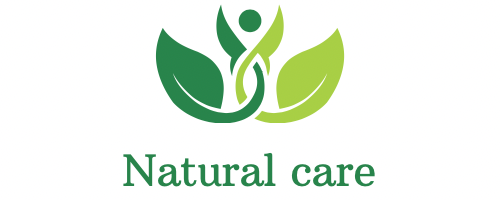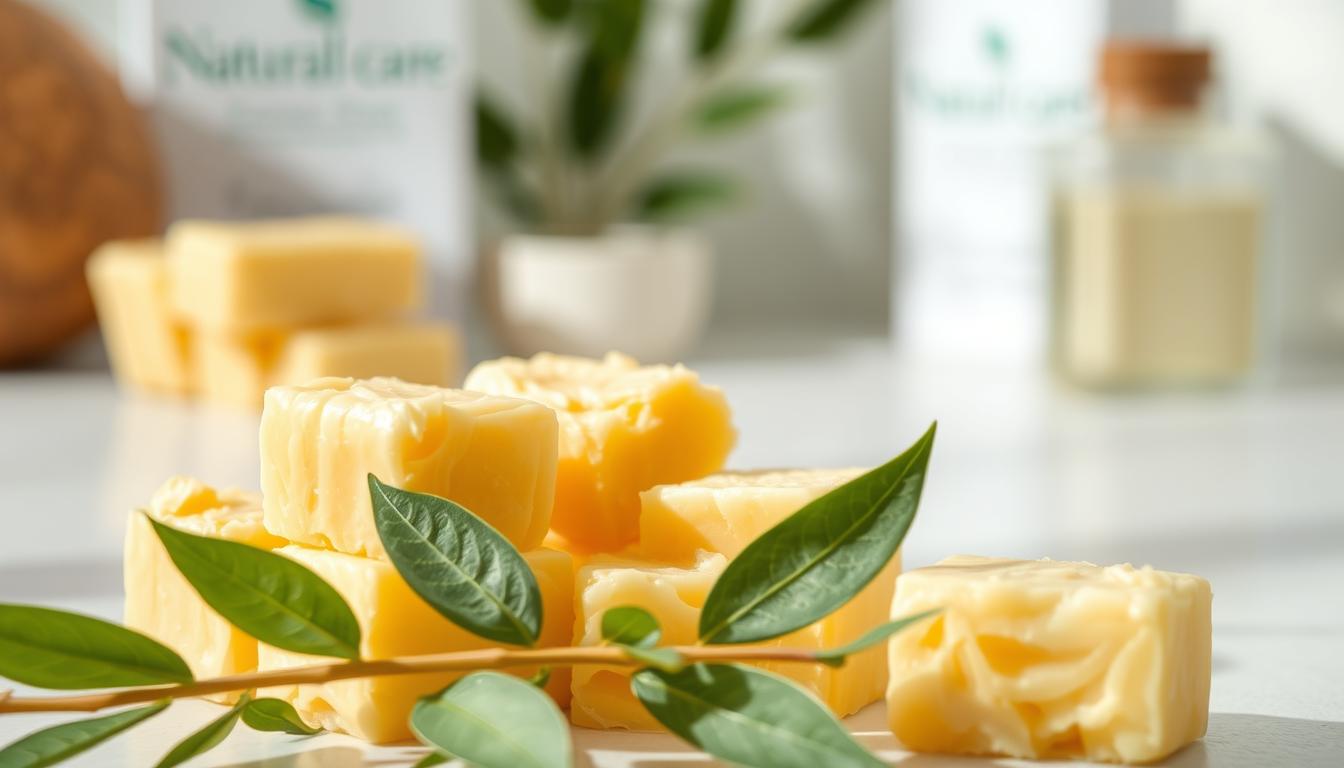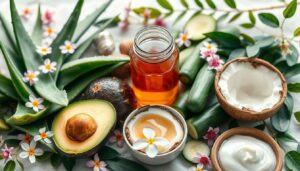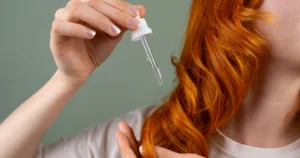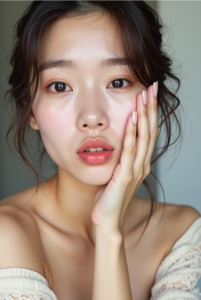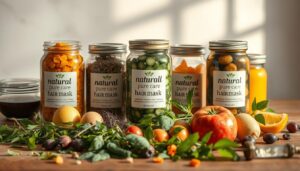Organic Shea Butter: The Expert-Backed Secret for Glowing Skin and Natural Healing
Did you know shea butter is great for acne-prone skin? It comes from the African shea tree and has changed skincare for the better. Dermatologists like Dr. Rajani Katta say it’s rare for people to have an allergic reaction to it.
Shea butter is full of fatty acids like linoleic and oleic. These acids go deep into the skin to add moisture without blocking pores. Brands like La Roche-Posay and Farmacy use it in products like the Toleriane Double Repair Moisturizer and Honey Halo. Dr. Barbara Sturm’s anti-aging creams also include it to fight wrinkles and dark spots.
Now, organic shea butter is backed by science. It fixes dry skin with Bliss’ Lemon & Sage Body Butter and keeps hair healthy with Shea Moisture’s Deeply Moisturizing Masque. It’s good for all skin issues, thanks to both tradition and modern research.
Table of Contents
What Is Organic Shea Butter and Why It Matters
Shea butter comes from the karité tree, found in over 20 African countries. Pure shea butter keeps its natural goodness thanks to traditional methods. It’s free from additives.
It’s packed with stearic and oleic acids, vitamins A, E, and F. These help keep skin moist, fight dryness, and calm irritation.
The Natural Composition of Pure Shea Butter
- Fatty acids like oleic acid boost skin barrier function
- Vitamin A promotes cell renewal
- Vitamin E acts as a potent antioxidant
Unrefined shea butter keeps these nutrients best. It’s great for eczema or dry skin.
Difference Between Organic and Conventional Shea Butter
Organic shea butter avoids synthetic pesticides and chemicals. Look for USDA Organic or Fair Trade labels. This ensures it’s free from harmful toxins.
Studies show organic shea butter has 3x more vitamin E than refined types. Brands like Certified B Corporations follow strict ethical rules. They avoid over 700 harmful chemicals.
Sustainability and Ethical Considerations
Shea trees absorb CO2, acting as natural carbon sinks for the African savannah
Buying organic helps over 16 million women in West Africa. It brings in $200M a year. Ethical producers use solar power to cut down on emissions.
Choose brands that support women’s cooperatives. This boosts both social and environmental benefits.
The Rich History and Traditional Uses of Shea Butter
Shea butter’s story starts in West Africa’s sunny savannas. For centuries, women in Ghana, Burkina Faso, and Mali have gathered shea nuts. They turn these nuts into butter through hard work.
This golden treasure is more than just a beauty product. It’s part of cultural rituals, medicine, and everyday life.
- Shea nuts are gathered from the shea tree (Vitellaria paradoxa).
- Traditional processing involves cracking, roasting, grinding, and boiling nuts by hand.
- Women in villages often collaborate, passing techniques down through generations.
“Shea butter is life itself. It feeds our skin, our traditions, and our economies.” – A West African artisan
| Traditional Uses | Modern Uses |
|---|---|
| Medicinal remedies for wounds and burns | Cosmetic ingredients in face creams and soaps |
| Cooking oil in local dishes | Haircare products for moisture and shine |
| Rituals and cultural ceremonies | Skincare routines worldwide |
Today, shea butter connects ancient wisdom with modern wellness. Its journey from village markets to global shelves shows its timeless value. By learning about its heritage, you celebrate a legacy of sustainability and natural beauty.
Understanding the Different Types of Organic Shea Butter
Organic shea butter comes in different types, each with its own benefits. The main difference is in how it’s processed. Raw shea butter (Grade A) is barely processed, keeping lots of nutrients like vitamins A and E. It has a creamy texture and a natural nutty smell, perfect for sensitive skin. Unrefined shea butter grades like ivory (B) and yellow (C) are slightly processed. They offer a balance between purity and texture.
- Raw (Grade A): Pure, unrefined shea butter with a white-gray hue. Best for deep hydration and anti-inflammatory care.
- Ivory (Grade B): Slightly processed, smoother texture, and lighter scent. Retains most nutrients while being easier to spread.
- Yellow (Grade C): Contains additives like borututu root for softer texture. Less intense aroma but still nutrient-rich.
- Gray (Grade D): Heavily processed, smoother but with reduced natural benefits.
Color and scent can help you choose. Raw shea butter’s white-gray color means it’s minimally processed. Yellow hues suggest additives. Always look for “unrefined” on labels to keep nutrients in.
Raw shea butter is great for acne-prone skin because it absorbs quickly. Yellow grades are better for dry or mature skin because they offer more moisture. Your skin type and needs will help you pick the right one.
Remarkable Skin Benefits of Natural Shea Butter
Discover the shea butter benefits that make it essential for healthy skin. It helps with dryness and environmental stress. Shea butter for skin offers deep repair and protection.
Its natural fatty acids and vitamins work with your skin. They restore balance without clogging pores.
How Shea Butter Moisturizes and Repairs Skin
Shea butter has oleic, stearic, and linoleic acids that create a protective barrier. This barrier locks in moisture. It also has vitamins A and E to repair dryness and flakiness.
Studies show it soothes eczema in days. Apply a thin layer at night to rebuild your skin’s lipid layers.
Anti-Aging and Anti-Inflammatory Properties
Shea butter has anti-inflammatory compounds like lupeol and salicylic acid. These reduce redness and swelling. A 2012 study confirmed it inhibits inflammation.
The triterpenes in unrefined shea boost collagen. This softens wrinkles and improves elasticity. It also has an SPF of 3-4, protecting skin from UV damage.https://www.naturalpurecare.com/retinol-retinal-visibly-rejuvenated-skin/
Treating Specific Skin Conditions with Shea Butter
- Eczema/Psoriasis: Apply a pea-sized amount twice daily to affected areas.
- Sunburn: Its cooling effect neutralizes heat and repairs burned skin.
- Scarring: Regular use over 4-6 weeks visibly reduces marks due to cell regeneration.
Choose unrefined shea butter for maximum potency. Look for USDA Organic labels to ensure no harmful additives. Pair it with gentle cleansers for a routine that works with your skin’s natural balance.
Transforming Your Hair Care with Shea Butter
Shea butter is a natural solution for dry, damaged, or frizzy hair. It has fatty acids and vitamins A and E that repair hair. It works well for all hair types, including curls, coils, and color-treated hair, without weighing it down.
- Moisturizes dry strands and seals cuticles for shine
- Reduces breakage by strengthening hair follicles
- Calms itchy scalps with anti-inflammatory properties
- Enhances curl definition for textured hair types
| Application | Benefit | Best For |
|---|---|---|
| Pre-shampoo treatment | Locks in moisture before washing | Curly/coily hair |
| Leave-in treatment | Controls frizz between washes | Fine to medium hair |
| Scalp mask | Exfoliates and nourishes roots | Dry or flaky scalps |
Begin with 1-2 teaspoons of shea butter for most hair types. Mix it with coconut or argan oil for extra moisture. Warm a tablespoon and apply it from roots to ends for a deep treatment. Leave it on for 30 minutes before washing.
Adding essential oils like lavender can improve scalp circulation. Using it nightly can even thicken your brows and lashes.
Opt for unrefined shea butter for the most nutrients. Choose brands certified by organizations like the African Fair Trade Society. Regular use will make your hair softer and easier to manage, without harsh chemicals.
How to Use Organic Shea Butter in Your Daily Routine
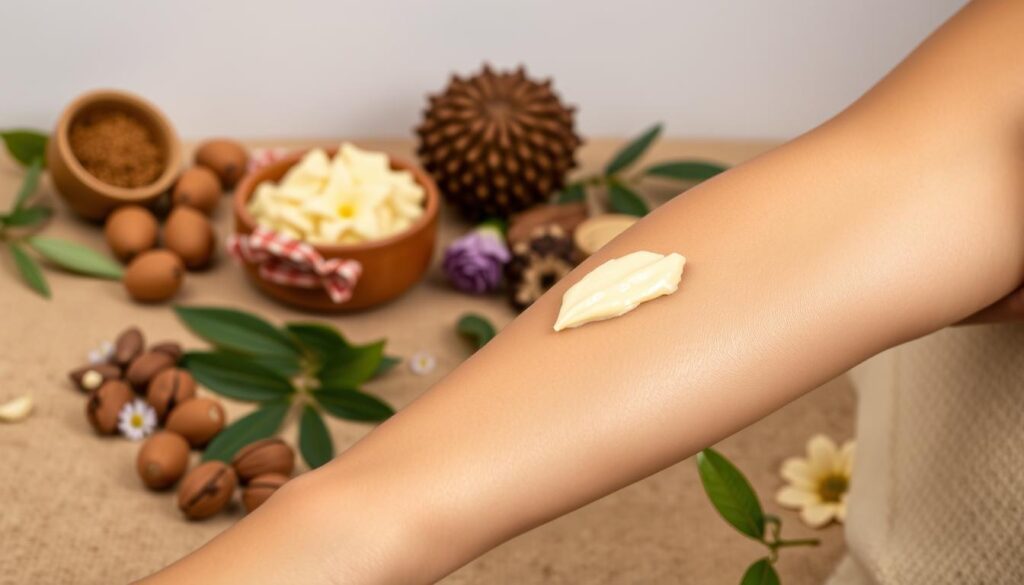
Begin your day with organic shea butter. Warm a small amount in your palms until it’s soft. Then, gently rub it into damp skin after your shower for deep hydration. It’s great for elbows, heels, or cuticles for extra moisture.
For your face, apply a thin layer to avoid clogging pores. Here’s how to get the most out of it:
Application Methods for Face and Body
- Face: Use a pea-sized amount as a night cream. Avoid the eye area.
- Body: Apply to damp skin to lock in moisture. Focus on dry patches.
- Hair: Rub a small amount between palms and smooth through ends. Leave in for frizz control.
DIY Recipes and Formulations
Try this simple recipe for a whipped body butter:
- 2 oz unrefined shea butter
- 1 tbsp coconut oil
Mix until fluffy. Store in a cool place for up to 6 months. Add lavender oil for relaxation or lemon oil for a citrus scent.
Combining with Natural Ingredients
Enhance your routine by blending natural shea butter with:
| Ingredient | Benefit |
|---|---|
| Vitamin E oil | Prolongs shelf life and boosts antioxidants |
| Honey | Moisturizes and soothes irritated skin |
| Tea tree oil | Adds antimicrobial properties for acne-prone skin |
Remember: Always patch test new mixes. Store in a cool, dark place. For best results, use weekly for hair and daily for skin.
How to Identify the Best Shea Butter Products
When you’re looking for shea butter, it’s important to know what to look for. This ensures you get the best shea butter that really works. The quality of pure shea butter depends on how it’s processed, where it comes from, and if it’s real. Here’s how to find the best products and avoid the bad ones.
“The purest shea butter retains its natural scent and texture, a testament to minimal processing.”
Quality Indicators to Look For
First, check these signs of quality:
- Color: Choose ivory or light yellow. Gray or green means it’s not pure.
- Scent: A mild nutty smell is good. If it smells like chemicals, it’s not natural.
- Texture: It should be smooth and easy to spread. If it’s gritty, it’s not right.
- Grade: Look for Grade A for the most nutrients. Lower grades might not be as good.
Reading Labels and Certifications
Check these things on the packaging:
- Certifications: Look for USDA Organic or Fair Trade to know it’s ethically made.
- Ingredients: It should only say shea butter. No palm oil or paraffin.
- Processing info: “Unrefined” or “raw” means it’s kept its nutrients.
Storage and Shelf Life Considerations
To keep your shea butter fresh, follow these tips:
- Keep it in a cool, dark place to stop it from going bad.
- Use airtight containers to keep air out.
- Check the expiration date—unrefined shea butter lasts 12–18 months if stored right.
Common Misconceptions About Shea Butter
Many myths about shea butter stop people from using it right. Here’s the truth behind the myths:
| Myth | Fact |
|---|---|
| Shea butter clogs pores | Rated 0–2 on the comedogenic scale, it’s unlikely to cause breakouts. Its fatty acids like stearic and oleic align with skin’s natural oils. |
| All products are the same quality | Processing methods matter. Unrefined versions retain vitamins A, E, and F for better efficacy. |
| Color/scent variations mean defects | Natural hues (ivory to yellow) and nutty scents signal purity, not impurity. |
| Causes frequent allergies | Rare reactions occur. Patch test first by applying a small amount for 24 hours. |
Quality is key. Brands like Dermaviduals use DMS technology to improve absorption. Always check how it’s processed and choose unrefined for the best results. Keep it in a cool, dry spot to keep its vitamins and fatty acids fresh. When used right, shea butter works well without harsh chemicals.
Conclusion: Embracing the Power of Organic Shea Butter for Natural Beauty
Organic shea butter is a top choice for natural skincare. It’s filled with vitamins A, E, and F that deeply nourish the skin. Studies show it can increase hydration by 80% and make skin softer by 60%.
Choosing organic shea butter from brands like CB Beauty Naturals or Institut Karité helps communities. It supports fair trade and ethical practices. This way, you get to enjoy its benefits while doing good.
Products like Institut Karité’s Shea Hand Cream So Chic use 20–25% shea butter. This shows its effectiveness in skincare. Brands like these source shea butter fairly, supporting sustainable agriculture and women-led cooperatives in Africa.
Now, 75% of consumers prefer natural ingredients. This demand has made the global shea butter market worth $2.5 billion. It’s clear that clean beauty is on the rise.
Use organic shea butter as a moisturizer, scrub, or in your nighttime routine. It has anti-inflammatory and anti-aging properties. It meets your skin’s needs and offers glowing, nourished skin without harsh chemicals.
Organic shea butter is a bridge between ancient wisdom and modern wellness. It’s a go-to for radiant skin, backed by centuries of knowledge and science.
FAQ
What is organic shea butter?
What are the benefits of using organic shea butter for skin?
How does organic shea butter differ from conventional shea butter?
Can I use shea butter for my hair?
What is the best way to apply shea butter?
How should I store shea butter to maintain its quality?
Is there a difference between raw and refined shea butter?
Can anyone use shea butter on their skin?
Are there any myths about shea butter I should be aware of?
What should I look for when purchasing shea butter?
Source Links
- For Silky, Smooth Skin, Add Shea Butter to Your Lineup—20 Best Products I’ve Ever Tested
- 8 Best Natural Oils for Healthy Skin
- What to Know Before Using Pure Shea Butter on Skin and Hair
- Organic Shea Butter
- Shea Butter for Skin: Top Benefits and Best Uses – MeridaSKIN
- Shea Butter Benefits | History + Best Uses + How to Apply
- Shea Butter: extraction, virtues, and uses at Druide Bio
- Exploring the Rich World of Unrefined Shea Butter: Nature’s Golden Gift
- Yellow Shea Butter Vs White Shea Butter: What Is The Difference?
- The Magic of Organic Shea Butter: Why It’s the Star Ingredient in Our
- Shea Butter for Skin: Top Benefits and Best Uses – MeridaSKIN
- 5 Surprising Uses of Organic Shea Butter Beyond Skincare
- How to Incorporate Shea Butter into Your Hair Care Routine
- From Hydration to Healing: How Shea Butter Transforms Your Skin Naturally
- Shea Butter for Skin: Top Benefits and Best Uses – MeridaSKIN
- The Benefits of Shea Butter for Hair and How to Make Your Own
- Refined v Unrefined Shea Butter | Which is Best?
- Exploring the Rich World of Unrefined Shea Butter: Nature’s Golden Gift
- Natural vs. Synthetic: Debunking the Effectiveness Myth
- The Unseen Benefits of Shea Butter: A Non-Comedogenic Marvel in Skinca
- Natural vs. Synthetic: Debunking Myths About Skin Care Ingredients in Products
- The Ultimate Guide to Shea Butter Scrub: Exfoliating and Nourishing Your Skin
- The Benefits of Shea Butter for Your Skin: Naturally Glowing with CB Beauty Naturals
- Celebrating the Magic of Shea butter with Institut Karité
